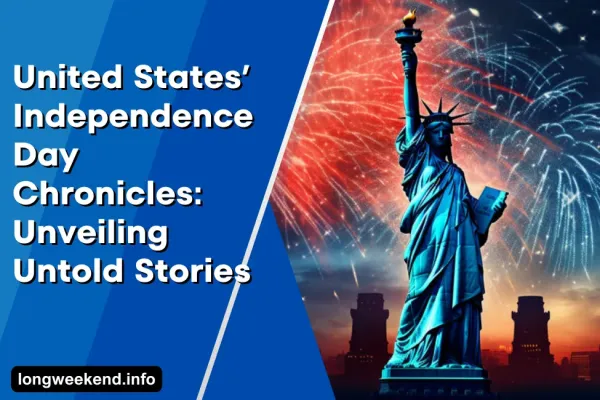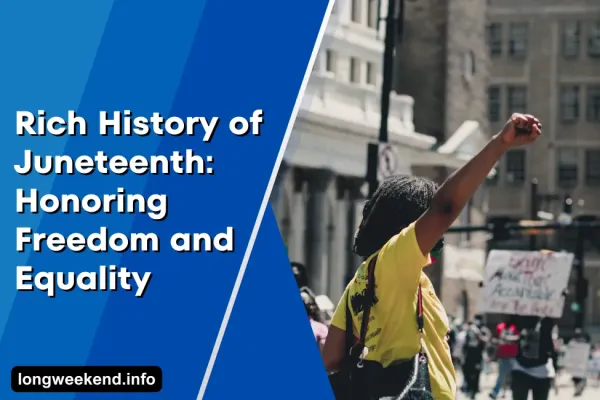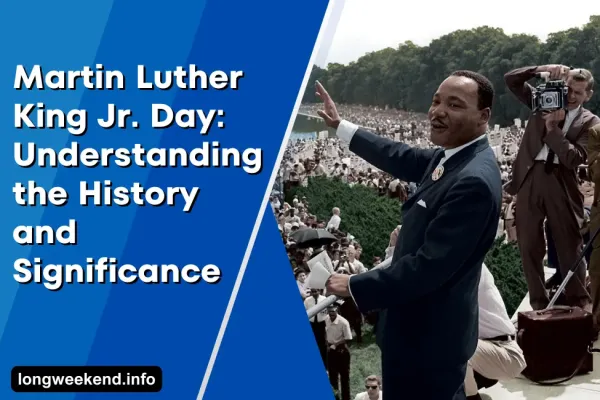Independence Day, also famously known as the Fourth of July, holds a profound significance in American history. Its roots trace back to the pivotal year of 1776 when a momentous event occurred—the Continental Congress came together to adopt the Declaration of Independence. This remarkable document boldly asserted the American colonies' desire to break free from British rule, establishing their identity as an independent nation.
Beginnings of Independence Day in the United States
Amid the embryonic stages of the revolutionary upheaval during the 1760s and early 1770s, patriots voiced their dissidence against the edicts of the British Parliament through jubilant congregations. Notably, they concurrently extolled King George III for safeguarding English liberties. Nevertheless, a pivotal transformation transpired in the summer of 1776 when the inaugural celebrations of autonomy assumed a distinctive demeanor across diverse localities. Simulated obsequies were orchestrated for the monarch, emblematic of the termination of monarchy and despotism while heralding the advent of liberty.
-
Early Years
In the nascent years of the nation, Independence Day was characterized by processions, fervent orations, and spirited libations. These ceremonials not only commemorated the genesis of the nascent nation but also played an indispensable role in the burgeoning federal political apparatus. As political factions commenced their formation, these festivities metamorphosed into a forum where both leaders and constituents could interrelate local and national quandaries with the foundational notion of independence.
-
19th Century
The 19th century witnessed Independence Day replete with verbose discourse and grandiloquent addresses, rendering it a solemn yet facetious affair. This paralleled the political milieu of the era, which was gaining popularity and embracing democratic principles.
As American society burgeoned and diversified, the Fourth of July evolved into a patriotic tradition cherished by various factions, transcending partisan demarcations. Abolitionists, advocates of women's rights, proponents of temperance (restricting alcohol consumption), and opponents of immigration all seized Independence Day as a conduit to articulate their convictions. Frequently, they vocalized their incapacity to partake in the communal jubilation when events incongruent with their beliefs unfolded.
-
Later in 20th century
The 19th century bore witness to Independence Day evolving into an affair replete with eloquent addresses and grandiloquent rhetoric, maintaining its gravity yet embracing elements of levity. This transformation mirrored the political landscape of the time, which was becoming increasingly favored and democratic.
As American society expanded and diversified, the Fourth of July metamorphosed into a patriotic tradition cherished by various factions, transcending political boundaries. Abolitionists, champions of women's rights, temperance enthusiasts, and immigration adversaries all harnessed Independence Day to articulate their convictions. Frequently, they voiced their inability to partake in the communal celebration when events at odds with their beliefs transpired.
Traditions and Customs of Independence Day
To celebrate Independence Day, Long Weekend wishes to share some ways in which Americans observe this holiday.
- Grilling: Across the nation, barbecues featuring hamburgers, sausages, hot dogs, and steak are a quintessential facet of the celebration. These backyard cookouts cultivate a sense of community and unity, shared with family, friends, and neighbors.
- Observing Fireworks: A visit to the local fireworks emporium to acquire sparklers, ground flowers, and Roman candles has become a cherished American tradition, often extending beyond the Fourth of July itself.
- Participating in the "Vote in Honor of a Vet" Program: Several states host initiatives where voters can dedicate their votes to veterans who have defended the nation, safeguarding freedom and democracy. This practice forges a meaningful nexus between patriotism and civic responsibility.
- Displaying the Flag: While military installations commemorate Independence Day with a noon artillery salute, neighborhoods frequently unfurl the American flag as a symbol of gratitude for the sacrifices made by troops.
- Extending Birthday Wishes to Citizens Turning 18 on July 4th: In numerous states, citizens who will reach the age of 18 before an impending election can pre-register to vote. Election officials frequently convey special felicitations to these nascent voters, entwining their birthdays with the nation's anniversary.
- Attending a Procession: Americans possess a lasting fondness for processions, ranging from nocturnal marches to diurnal spectacles, featuring floats, equines, cheerleaders, military units, and marching bands.
- Adorning Red, White, and Blue: Citizens don their finest garments in red, white, and blue hues, crafting a vibrant display of patriotism.
- Disseminating Crucial Democratic Deadlines: Independence Day serves as an opportune juncture for electoral offices to remind constituents of impending civic time limits, ensuring active participation in the democratic process.
- Contributing to the Community: Many electoral personnel and officials leverage July 4th as an occasion to volunteer and give back to the community, demonstrating appreciation for those who safeguard American liberties.
Symbols of Freedom to Appreciate on Independence Day
Our country's founders built the nation with a dream - to create a free land for its people. Unlike any other nation in the world, these unique freedoms are represented by special symbols that are cherished by the citizens, especially on Independence Day. Now, let us embark on an exploration of twelve symbols emblematic of freedom in the United States, elucidating their significance.
-
The Liberty Bell
Situated within the confines of Philadelphia, Pennsylvania, rests the iconic Liberty Bell, bearing the indelible inscription: "Proclaim Liberty Throughout all the Land Unto all the Inhabitants Thereof." This venerable artifact played an instrumental role in marking America's Declaration of Independence, its resounding peal resonating when the hallowed Declaration was first unveiled to the world in 1776
-
The Washington Monument
The Washington Monument, a towering obelisk, gracefully ascends to a majestic height of 555 feet (169 meters). A profound tribute to President George Washington, the leader of the Continental Army and the inaugural President of the United States, this monument stands as a testament to American courage. Revered as "the greatest character of the age" by King George III, Washington is hailed as one of the founding fathers of the nation. The monument's construction, accomplished using granite, marble, and bluestone gneiss, represented a remarkable architectural feat of its era.
-
The Rose
The rose earned the distinction of becoming America's national flower in 1986 because of its symbolic representation of love for the country. The rose fosters a sense of belonging to the nation and is cherished by Americans as a symbol of beauty and resilience that characterizes America. The choice of the rose as the national flower came after extensive debate, partly due to fossil evidence showing that it has been growing in the country for centuries. Even the White House has a large rose garden, and President Washington himself was known for cultivating many varieties of roses on his property.
-
The United States Constitution
The United States Constitution, serving as the supreme law of the land, emerged from the crucible of the 1787 Philadelphia Convention and was officially ratified in 1789. This seminal document outlines the structural foundations of the government, enshrining the Bill of Rights as its integral amendments, guardians of the freedoms and rights enshrined for American citizens. Comprising a Preamble with seven sections, the Constitution also encompasses twenty-seven provisions in its Amendments section, alongside an additional five sections housing unratified amendments.
-
The American Flag
The American Flag, affectionately known as Old Glory, boasts thirteen crimson horizontal stripes that oscillate in harmony with white bands. Adorning the upper left quadrant, a field of blue proudly hosts fifty stars, each symbolizing a state within the nation. The flag's genesis dates back to the Grand Union flag of December 3, 1775, eventually evolving into the thirteen-star version on June 14, 1777. The current design, attributed to Robert G. Heft, attained official status in 1960. The Stars and Stripes flutter gallantly across the nation, gracing schools, residences, commercial establishments, and highways alike.
-
Mount Rushmore
Mount Rushmore stands as an imposing sculptural marvel etched into the rugged visage of a mountain. It proudly showcases the visages of Presidents George Washington, Thomas Jefferson, Theodore Roosevelt, and Abraham Lincoln—custodians of American sovereignty and architects of domestic harmony. Crafted under the stewardship of Gutzon Borglum from 1927 to 1941, each colossal head attains a towering height of sixty feet, perched at an elevation of 5,725 feet (1,745 meters) above sea level.
-
The Star-Spangled Banner
The Star-Spangled Banner serves as the mellifluous national anthem of the United States, its genesis traceable to a poem penned by Francis Scott Key on September 14, 1814, titled "Defense of Fort M'Henry." Composed whilst Key languished as a captive aboard a British vessel, he beheld the Battle of Baltimore unfold before his very eyes. Through the maelstrom of dust and smoke, the enduring image of the American Flag gallantly unfurled signaled victory, an anthem that reverberates before sporting spectacles, paying homage to a British composition titled "To Anacreontic Society."
-
The Bill Of Rights
The Bill of Rights, an integral component of the United States Constitution, meticulously enumerates the innate rights afforded to every American citizen. Officially embraced by the U.S. government in 1789 and subsequently ratified in 1791. This venerable document stands as an impervious bulwark, shielding these rights from encroachment by private individuals or government functionaries. The Bill of Rights remains immutable, requiring widespread consensus or a specialized vote for any prospective amendments or omissions.
-
Uncle Sam
Uncle Sam, an enigmatic personification, represents the American government and the United States in its entirety. This emblematic figure embodies a profound love for the country and its rich cultural heritage. Frequently invoked in the context of military recruitment, the exact origins of Uncle Sam remain shrouded in mystery, though the consensus places its rise to prominence during the War of 1812, purportedly inspired by an individual named Samuel Wilson.
-
The White House
The White House, situated at 1600 Pennsylvania Avenue, serves as the official abode and workspace of the President of the United States. Since the tenure of John Adams in 1800, every President has called it their residence. Additionally, the term "White House" encompasses not only the presidential residence but also extends to encompass the President and their cadre of advisers.
Designed by James Hoban, an Irish-born architect, the edifice was constructed from 1792 to 1800, employing Aquia Creek Sandstone that would later be cloaked in a pristine white veneer. Notably, the White House fell victim to British arson during the War of 1814, a calamity that necessitated extensive restoration and reconstruction efforts over subsequent years.
Today, the White House boasts several distinct components, including the Executive Residence, the West Wing, the East Wing, the Eisenhower Executive Office Building, and the Blair House, designated for official guests.
-
The American Bald Eagle
The Bald Eagle, a majestic avian emblem, personifies the United States of America, signifying liberty and resilience. Its ascension to the status of a national symbol occurred on June 20, 1782, when it supplanted the smaller white eagle on the Great Seal of the United States. This noble creature graces American currency, official documents, architectural edifices, flags, and a plethora of government paraphernalia. Despite its cherished status, the Bald Eagle faced dire peril on numerous occasions.
In 1940, Congress enacted the Bald Eagle Protection Act, criminalizing the killing, sale, or ownership of these avian treasures. In the 1960s, the species faced further adversity, its population dwindling due to the consumption of prey tainted with the chemical DDT, a residue of World War II. Through vigilant governmental protection and the regulation of DDT, the Bald Eagle population gradually rebounded, once again thriving in the American landscape.
-
The Pledge Of Allegiance
The Pledge of Allegiance represents a solemn vow, affirming one's steadfast loyalty to both the American flag and the nation it symbolizes. Conceived by Francis Bellamy in 1892, it earned a congressional endorsement in 1942. The appellation "The Pledge of Allegiance" materialized in 1945, accompanied by the inclusion of the phrase "under God."
Recited at the outset of momentous governmental proceedings, the commencement of school days for new U.S. citizens, and various other occasions, this pledge epitomizes a heartfelt demonstration of love for the nation and an ardent expression of pride.
Looking Back in History
Upon reflection, the Fourth of July, which commemorates America's Declaration of Independence, might seem to novices as nothing more than a hiatus from scholarly pursuits, an extended weekend replete with joyous festivities. However, its import transcends mere revelry, serving as a poignant testament to the trials and tribulations endured by our forebears in their quest for liberty and the formulation of democratic principles that continue to underpin the very essence of the United States.
Over time, the Fourth of July has evolved into a nationally revered occasion, adorned with displays of patriotism, parades, and both collective and individual observances of our nation's rich history and enduring customs.
From the Star-Spangled Banner unfurling gracefully in the summer breeze to the melodious refrains of patriotic hymns performed by marching ensembles, each facet contributes to the intricate tapestry of this day. The prevailing spirit of unity, a profound sense of pride in our great nation, and a shared sentiment of belonging that Independence Day fosters underscores its profound significance within the mosaic of American culture.
Independence Day, beyond its exuberant celebrations, exerts a lasting influence on American society and culture. This national commemoration serves as a poignant reminder of the foundational tenets upon which our nation was established: liberty, justice, and democracy. It perpetuates the concept of the American Dream, an ethos underscoring the belief that freedom begets opportunity and prosperity through diligent labor.
Throughout history, Independence Day has morphed into a communal engagement, with citizens actively participating in local activities, outreach initiatives, and civic causes. This emblematic day embodies the spirit of communal inclusion and a shared sense of belonging to a greater whole.
-
Key Historical Events on Independence Day
Apart from the usual celebrations, Independence Day has also seen some very important events in American history.
- The Erie Canal, a pivotal trade route crucial to the country's westward expansion, was inaugurated on July 4, 1817.
- The Baltimore and Ohio Railroad, the first common carrier railroad in the United States, commenced construction on Independence Day in 1828.
- On July 4, 1960, the 50-star American flag made its debut after Hawaii attained statehood.
- These occurrences exemplify the profound historical significance of Independence Day and its role in marking America's progress over the years.
Independence Day and Sports
Patriotism, synonymous with fervent belief in one's nation, finds its zenith on Independence Day. Commemorating this day by partaking in sporting events, whether on an international scale or as Grand National spectacles, can foster a profound sense of unity and national pride. A densely packed stadium, replete with enthusiasts collectively witnessing a riveting spectacle, is a potent experience. Here are the top five sporting events that evoke patriotic sentiments on Independence Day:
-
The Super Bowl
Whether it be the inspiring narrative of the New Orleans Saints in 2010 or the astonishing upset by the New York Giants in 2008, the Super Bowl has generated countless memories for football aficionados. What distinguishes the Super Bowl is its capacity to draw both ardent fans and casual observers. The sheer grandeur of the event deems it a must-watch. As the game commences and the action unfolds, a deluge of camera flashes illuminates the packed stadium, affording homebound fans the sensation of not being alone in savoring this extraordinary spectacle.
-
The World Series
What can be more emblematic of Americana than the country's cherished pastime? The World Series is a timeless classic, where two teams vie for the coveted title of World Series Champions. Similar to the Super Bowl, devoted fans from across the nation come together, cheering for disparate teams but uniting in their shared love for the sport.
Whether celebrating a victory over the "Evil Empire" in New York or witnessing an underdog triumph in San Francisco, every fan has a stake in this series. The Super Bowl and the World Series may be disparate sports, yet they share a fundamental trait. They possess the ability to unite people from every corner of the country in one stadium for an enthralling series, promoting unity and underscoring the greatness of entertainment in this nation.
-
The Daytona 500
Given its proximity to July 2nd, the Daytona 500 is a natural choice for Independence Day celebrations. American flags wave, fans exult, and drivers seek to earn the admiration of all. While NASCAR may not rival baseball or football in scale, it commands followers at every racetrack. The Daytona 500 serves as a prelude to Independence Day revelries for all NASCAR enthusiasts. It stands as the premier race of the year, captivating a devoted fan base. Owing to its timing, every fan watching holds America in their thoughts.
-
The World Cup
The World Cup, whether in men's or women's soccer, elicits patriotic fervor due to its international nature. Teams from around the globe contend in the most significant soccer tournament of the year, drawing passionate fans who rally to support their respective nations. Soccer enthusiasts and players often infuse drama into the game, intensifying the sense of patriotism as each team vies to advance.
International sporting events offer each participating country a unique platform to showcase their skills in a more benign manner than usual. The World Cup excels at uniting Americans and providing them with a common cause to cheer for.
-
The Olympics
The Olympics enjoy the distinction of encompassing two seasons, both winter and summer. This allows fans to root for their countries in two diverse events. The Olympics stands as the largest international sporting event worldwide. The plethora of events ensures there's something for everyone to relish. The opportunity to display athletic excellence on a global stage is a rarity. The chance to rally behind one's country is equally exceptional. Consequently, the Olympics emerged as the most patriotic event globally, irrespective of the season.
Movies to Enjoy on the Fourth of July
What better way to commemorate this momentous day than by viewing films that authentically capture the essence of America? Films possess a unique ability to transport us through time and provide insight into American history, culture, and the indomitable American spirit. Here are five movies that will enhance your Independence Day celebrations, seamlessly blending entertainment with edification
-
1776
"1776" is a captivating musical that transports you to the period just before the signing of the Declaration of Independence. The film artfully portrays the intense debates and challenges confronted by the founding fathers as they strove for independence from British rule. With catchy melodies and compelling performances, "1776" offers a delightful yet instructive experience. The movie accentuates the complexities of democracy, the sacrifices made by those who fought for freedom, and the imperative of unity when confronting adversity. It stands as an excellent choice to commence your American Independence Day film marathon.
-
Lincoln
Directed by Steven Spielberg and featuring an amazing performance by Daniel Day-Lewis, Lincoln gives you a fascinating glimpse into the life and impact of one of America's most respected presidents. Set during the last months of Abraham Lincoln's presidency, the film tells the story of his efforts to handle the challenges of the Civil War and pass the Thirteenth Amendment, which ended slavery.
With its great storytelling and careful attention to historical accuracy, Lincoln immerses you in the political complexities and moral dilemmas faced by Lincoln and his team. The movie explores themes of leadership, moral bravery, and the unwavering pursuit of justice. Lincoln is a thought-provoking and inspiring film that sheds light on a crucial moment in American history and the ongoing fight for equality. This is a must-watch for your American Independence Day movie marathon.
-
Forrest Gump
Forrest Gump is a heartwarming and funny film that spans many decades of American history. Tom Hanks delivers an excellent performance as the lovable and naive Forrest Gump, who unexpectedly finds himself part of major historical events, from the Vietnam War to the Watergate scandal. The movie serves as a nostalgic look at American culture, touching on themes of love, friendship, and the search for happiness. Forrest Gump reminds us of the resilience and optimism that have shaped America, making it a perfect choice for your American Independence Day movie marathon.
-
Glory
Glory is a powerful and moving war film that sheds light on a lesser-known aspect of American history—the involvement of African-American soldiers in the Civil War. Starring Denzel Washington, Morgan Freeman, and Matthew Broderick, this gripping story follows the 54th Massachusetts Volunteer Infantry, one of the first all-black regiments in the Union Army.
Glory explores themes of racial prejudice, bravery, and the fight for equality. By showcasing the sacrifices and heroism of these brave soldiers, the movie highlights the ongoing struggle for freedom and civil rights in America.
-
Apollo 13
Apollo 13 is an exciting and inspiring true story that celebrates one of America's most incredible achievements—the Apollo moon landing program. Directed by Ron Howard, the film tells the story of the ill-fated Apollo 13 mission, which faced a critical technical failure in space. Tom Hanks, Kevin Bacon, and Bill Paxton deliver outstanding performances as the astronauts who must rely on their ingenuity and teamwork to survive.
Apollo 13 demonstrates the unwavering determination and resourcefulness that define the American spirit, even when facing seemingly insurmountable challenges. It serves as a testament to human resilience and the triumph of the American space program. This is the perfect movie for any space enthusiast to enjoy on American Independence Day.
FAQs
- What's the story behind Independence Day in the United States?
Independence Day, also known as the Fourth of July, marks the approval of the Declaration of Independence in 1776. This important paper, written by Thomas Jefferson, announced that the 13 American colonies were free from British rule. It was a significant step in creating the United States as we know it today. This holiday shows how brave and determined the Founding Fathers were in shaping the nation's future.
- How do people celebrate Independence Day in the United States?
Independence Day is celebrated with a lot of excitement and passion all over the country. People come together for parades, firework shows, concerts, and ceremonies that celebrate their love for their country. Backyard barbecues and picnics are common, and families often get together to enjoy the day. This day is also famous for events like the Nathan's Hot Dog Eating Contest and the amazing firework displays that light up the night sky.
- Are there different ways to celebrate Independence Day in different areas?
Yes, celebrations for Independence Day can vary from place to place. While fireworks and patriotic events happen everywhere, the specific traditions and activities can differ from one state to another. For instance, the Boston Pops Fireworks Spectacular in Massachusetts and Macy's Fourth of July Fireworks Show in New York City are famous for their grandeur. Smaller towns and rural areas often have their unique celebrations that highlight community ties and local history.
- What are some safety tips for using fireworks on Independence Day?
Safety is the most important thing when it comes to celebrating Independence Day with fireworks. It's best to attend professional fireworks displays whenever possible. If you're using consumer fireworks, be sure to follow safety instructions carefully. Stay a safe distance away from fireworks, never try to relight one that didn't work, and have a bucket of water or hose nearby. Keep a close eye on children, and never point fireworks at people, animals, or buildings. Being safe ensures that everyone has a happy celebration.
- How can I make Independence Day more environmentally friendly?
Celebrating Independence Day in an environmentally friendly way is responsible and satisfying. Choose biodegradable decorations, use reusable dishes, and try to reduce plastic waste. Carpooling to events can cut down on emissions, and selecting fireworks with lower environmental impact is a good idea. Think about alternatives like laser light shows to limit air and noise pollution. Every small environmentally-conscious choice helps make the celebration more eco-friendly.
- Why is Independence Day important in today's world?
Independence Day is still very important in modern society as a symbol of freedom, democracy, and unity. It reminds us of the country's fundamental principles and the ongoing pursuit of liberty and justice for all. In a world with many challenges, Independence Day is a chance to think about the progress the nation has made and renew its commitment to the values it holds dear.
- What role does patriotism play on Independence Day?
Patriotism is a central part of Independence Day celebrations. It's a day when Americans show their love and loyalty to their country. Patriotism is displayed through actions like waving the American flag and singing the national anthem. It's also a time to honor veterans and those currently serving in the military who have made sacrifices for the nation. Patriotism on Independence Day strengthens the sense of belonging and national pride.





